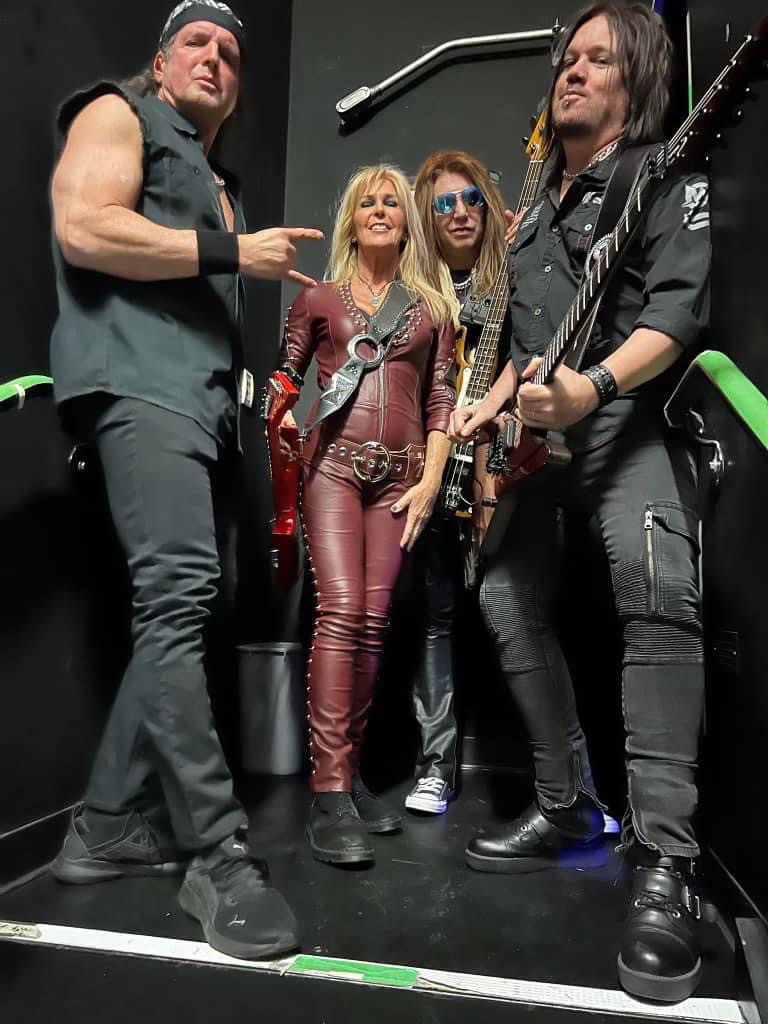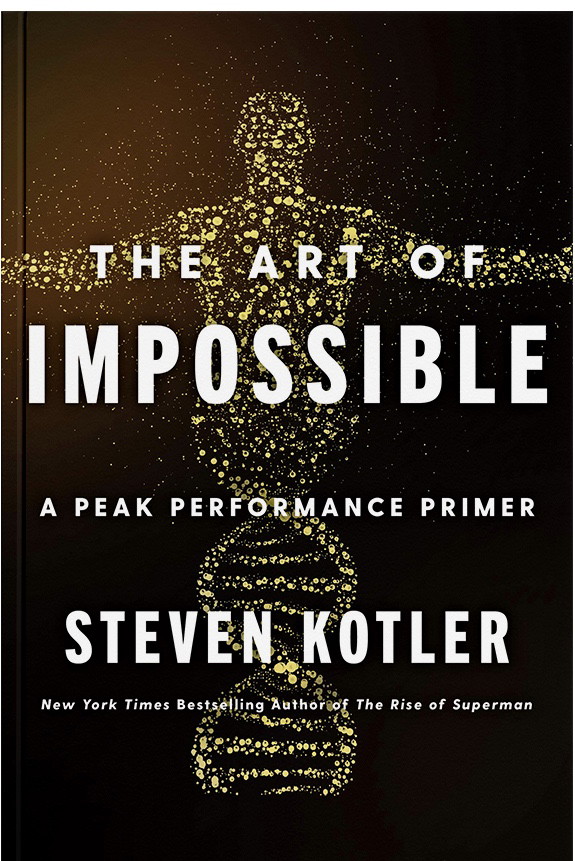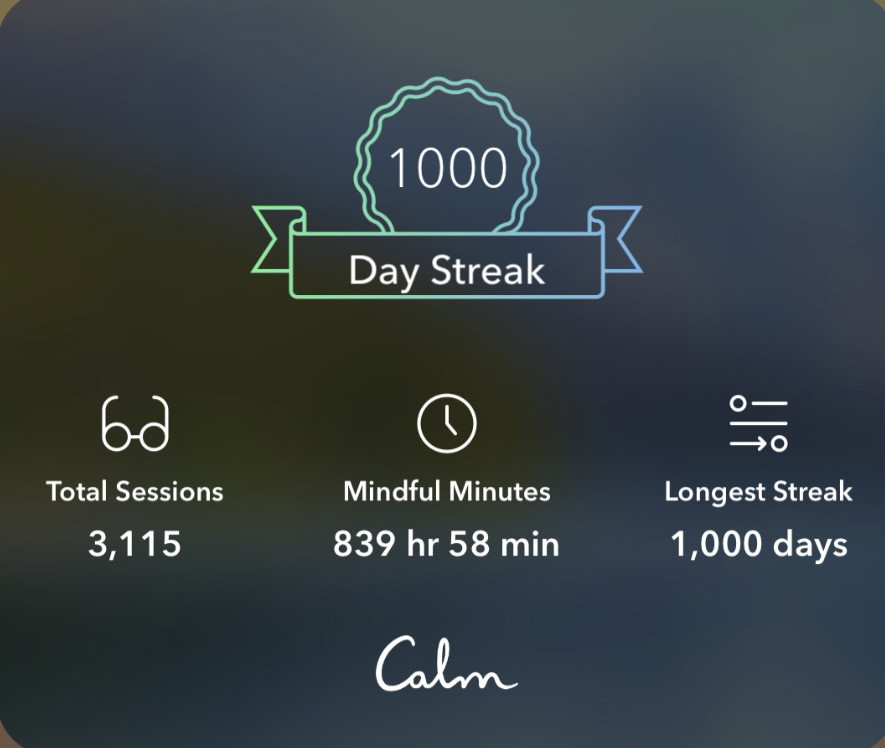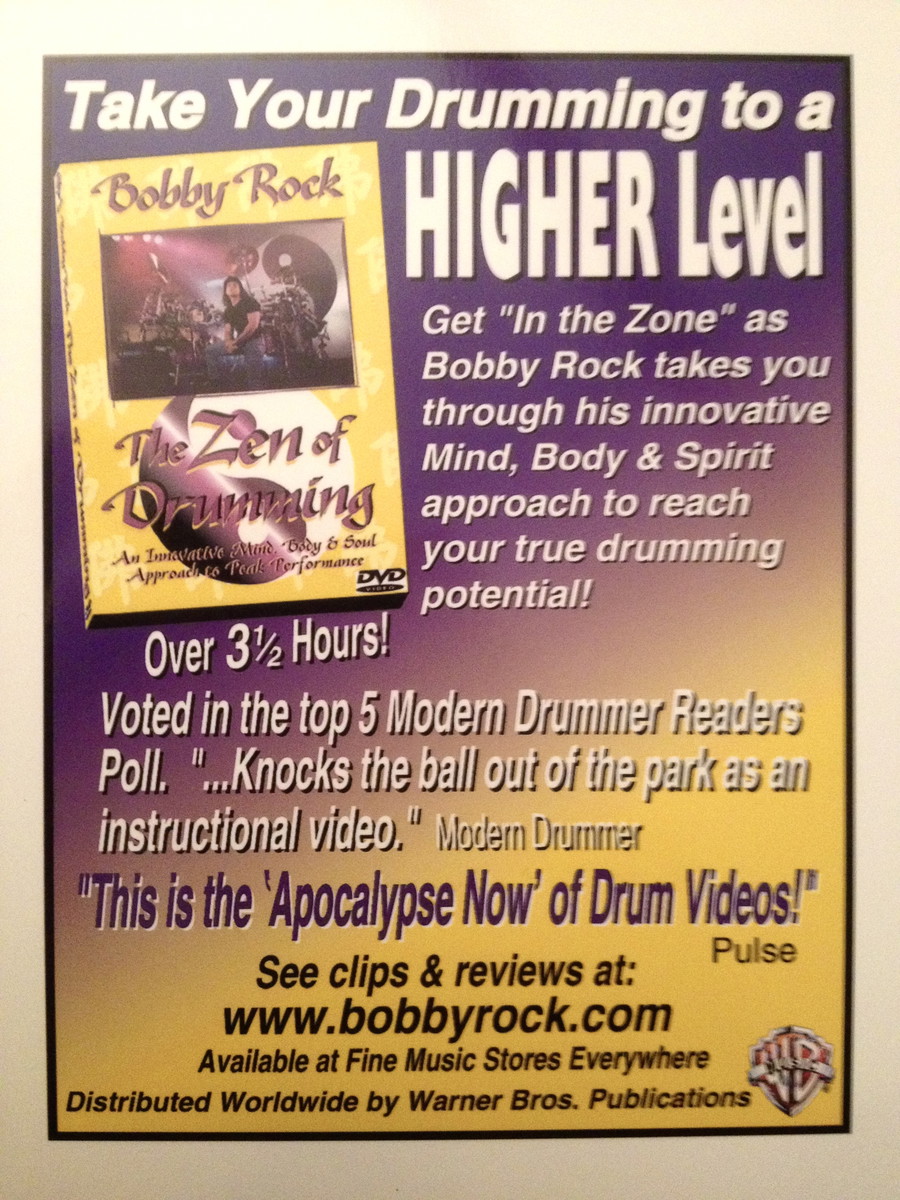The Bobby Rock Newsletter #99 (4-16-23) - Embracing Excess with "The Octopus"
The Bobby Rock Newsletter #99 (4-16-23) - Embracing Excess with "The Octopus"
|
To sign up for this Newsletter and/or to scope back issues, click HERE.
|
Hello, my Friends -
Welcome back, this time to the 99th issue of the BR Newsletter. Indeed, we are already working on a special edition for #100 next week. But first things first, as we get into another mixed bag of (hopefully) helpful and/or entertaining things for you here. Let’s jump!
In This Issue:
- It's Impossible!: Taking in some mind expansion from Steven Kotler’s killer book, The Art of Impossible. Countless nuggets in this one, but I’ll zero in on a game-changer today...
- 1000 Consecutive Days of Meditation: I tend to be a life landmark sort of guy (as many of you have already gathered), so I discuss a bit about hitting this one this past week.
- Embracing Excess with "The Octopus:" What does a one-bar groove utilizing 22 different sound-sources sound like? Unlike anything else! Revisiting this beautiful monstrosity from my instructional DVD, The Zen of Drumming (circa 2000)… and the cultural ramifications from the day.
+ + + + + + +
A recent pic from a Lita Ford show in Welch, MN, moments before stepping onstage.

It’s the calm before the storm this month, as more dates make their way onto our itinerary. As always, go HERE for the latest.
_______________
The Impossible

The Art of the Impossible has rapidly made its way toward my Top 10 Most Recommended Books of All Time list. Author Steven Kotler brings his award-winning journalist background into the art of achieving the impossible in a way that is at once engaging, scientific, and immediately useful. This is a smooth but dense read. And today, I just wanted to throw an idea from the book at you that I believe we can all take to the bank. It comes from a section in the book on fostering and developing creativity. He calls the idea: Non-Time and No One.
The idea is centered around a familiar one around here: for those of us involved with any creative endeavor, we are to spend solitary work/contemplation time, in an undistracted environment, as regularly as we can. The "no one" element is crucial. It simply means that you will strive to be alone when engaging this practice. But it's his non-time piece that I find most valuable. It's this idea that, while we may step into this "deep work" zone for a predetermined amount of time, we are not to give the clock any sort of consideration with regard to what we are working on. This is especially valuable for us writers, where we can often spend a disproportionate amount of time on a single paragraph, or even sentence. Here's how Kotler puts it:
If a sentence takes two hours to get right, who cares: this is non-time. If I have to write five paragraphs, throw them out, and write five more—well, there are no clocks in non-time. And creativity needs this non-time.
As I've always said about the writing process, it takes what it takes. We must honor the process in a space where “there are no clocks.”
Additionally, we know that the creative epicenter of the brain is generally considered to be the frontal lobe where, when fully engaged, we lose track of time. It seems to me that this “non-time” protocol is a way to reverse engineer our frontal lobe experience. As we aspire to work in non-time, we perhaps put ourselves in the best position to operate from the part of the mind that thrives in it!
Flow State
As a side-note here, a huge part of Kotler’s work in general—and a big part of this book—is the idea of visiting “flow state” regularly. And while this concept might be unfamiliar to some, in the past three decades, we have amassed a boatload of science to explain the phenomenon. In this book, Kotler details this science with painstaking clarity and, of course, discusses multiple ways of getting into flow state, with this non-time/no one practice being part of it. His ability to, essentially, codify several complex neurological principles into one accessible practice (which does require lots of effort and practice, by the way), is one of my favorite aspects of the book.
Allowing Your Brain its “Magic Time"
One other point about the contemplative aspects of non-time from Kotler:
Non-time is time for daydreaming and psychological distancing. Daydreaming switches on the default mode network. If the goal is to enable our subconscious to find remote associations between ideas, then we need this network engaged. We also need a little distance from our problems, which is another reason non-time is so crucial. This distance allows us to see things from multiple perspectives, to consider another’s point of view. But if we don’t have the time to get that psychological distance, to get space from our emotions and take a break from the world, then we won’t have the luxury of patience or the uplift of alternative possibilities.
This aspect speaks to the notion that we must “get out of our own heads” with regularity so the brain can go to work on our behalf. It calls to mind some sage writing wisdom I once read from author Neil Gaiman (paraphrasing):
Once you sit down for your allotted (creative or) writing time, whatever that may be (30 minutes, 60 minutes, 90 minutes, etc), you don’t actually have to write if you simply don’t feel like it. But… you can’t do anything else (like surf the web or check email). You have to just sit there.
I believe Neil’s point might have been that, in time, you will likely pull something up, start pecking away at the keyboard and, before you know it, be on your way to the business at hand. But I thought about the value in engaging some of Kotler’s non-time practice here, which calls to mind that famous Buddhist-tinged hit of wisdom:
"Don’t just do something: sit there!”
Indeed, just sitting inactively through some of your writing (or creative) time, without any other distractions, will allow for your brain to "find remote associations between ideas” and perform any other clean-up work it’s been trying to find time to do. So whether you write (or create) or not, it can still be a productive time.
More from The Art of Impossible soon!
Speaking of training for "flow state”...
_______________
1000 Consecutive Days of Meditation

Just celebrated 1000 consecutive days of meditation this week. I’ve had a practice for many years and I’ve been using this Calm app for the past few, which is cool because it keeps track of the days and times. As I scoped what I wrote some 270 days ago at the two-year mark, I found it all to still be on point:
Certainly, not every meditation session is a transcendent experience... but neither is every workout or practice session. But I do believe there is something about just showing up every day that's much better than NOT showing up every day. I find that structure in a meditation practice can be just as beneficial as structure in any other endeavor, like practicing, running, hitting the weights, or writing.
And, just like anything else we practice, we’re gonna see improvements. To that end, I’ve always thought of meditation like weightlifting for your brain. Little by little, you strengthen your mind and are able to bring a lot more intentionality into your life, as far as: controlling what kinds of thoughts and inner dialogues you let linger in your mind and which ones you gently escort the hell out, how quickly you tend to react to “unfavorable” happenings, and how effectively you can mitigate the inner-chatter, especially when it’s time to concentrate—like during a medi session. I find all of these skills to be quite useful!
I’ve also noticed this past year that when I defer any big responses or decisions to post-meditation time vs. the sooner-rather-than-later knee-jerk approach, I’m always happy I did. Typically, I find that whenever we react and/or make decisions when we’re either stressed, angry, or worried, we tend to default to the ol’ fight-or-flight "lizard brain" part of our consciousness and… let’s just say… that’s not exactly the locale where our most mindful and constructive thinking takes place.
+ + + + + + +
Over the past three months, I’ve had occasion to test my mindfulness practice a bit more regularly since becoming a first-time dad. Obviously, it is a joyous experience. At the same time, aspects of caring for a new human can be challenging, especially as sleep becomes compromised and fatigue sets in. I knew this was coming, so my goal was to just practice remaining calm and present, even when feeling fried. I figure, if I can’t do this, then what the fuck has all of this meditation practice been about? (Anyone can be “Zen” when life is tranquil and easy.) Isn’t my mind strengthening from my practice? If so, shouldn’t I be able to utilize this new strength by maintaining a sense of calm, even when I’m really burnt? I say yes.
And yet, I also acknowledge that, while meditation helps, there will still be an occasion here or there where maybe I fall a bit short in the patience department. But the idea is, I should be able to “be of strong mind” most of the time, and this remains my daily commitment… and yet another reason why daily practice is so important.
Next stop: Three consecutive years of meditation this summer.
Let’s rock this bitch...
For the full report on this meditation journey, check out my article, "This Is Your Brain On Meditation."
_______________
Embracing Excess with "The Octopus"
Some years back I featured a special groove on my DVD, The Zen of Drumming, called “The Octopus.” It’s a one-bar pattern that utilizes 22 individual sound sources, and it had become a much-requested favorite from my solo drumming appearances. (Link below!)

A magazine ad for The Zen of Drumming
The Concept
I spent the better part of 10 years—through most of the 90s and into the 2000s—earning my living almost exclusively as a solo drum guy. I did hundreds of clinics and exhibitions, and tons of shows with my own instrumental funk-rock power trio, mainly around North America. It was a grand period of my life (the extreme highs and lows of which I’m detailing in my next memoir).
Part of what you have to do as an educator, or proponent of the drumming arts—however you want to call it—is constantly dig deeper into the how and why of what you do. And part of my message, which extends all the way back to the mid-80s when I first started doing drum clinics, is that you always start with something basic, then expand from there.
“The Octopus” is kind of an extreme example of this concept. It’s based around a particular sticking pattern that one could play with great effect on a mere two sound sources… but that really takes on a new life when split up over 22, on a drum set that includes nine individual foot pedals. It’s a statement on what an ultra-expansive approach might mean to a basic musical idea. And—perhaps most importantly—it is, to my ears, exceptionally musical and not something you hear every day.
“The Octopus” also evolved into a logical counterpart to “The Monster,” another elaborate groove (in different ways) that I had published in my first book/video, Metalmorphosis, some 11 years prior. (Backstory featured in BR Newsletter #88. See link below.)
Here’s an interesting aside about how each of these “extreme” grooves hit my corner of the universe in their respective times.
“The Monster” was unleashed (so to speak) in 1989, at a time when excess was not only wildly popular throughout pop culture, but embraced and even expected. People loved it. “The Octopus,” I noticed, was often greeted with a bit more of an “alien encounter” kind of vibe, since 2000 culture still seemed to favor that neutral, early-90s minimalism. People didn’t know what to make of it (although, of course, many drummers still dug the concept).
Which leads us to this observation, as I wrote about in my blog back in 2014:
The Less-Is-More Culture
The more common approach is the good ol’ “less-is-more” vibe, and I do understand this. More often than not, we creative folks find that, indeed, less is more. That’s largely how great editors help writers, or great producers help musicians. By pointing out ways that we can “tighten up” on this paragraph, or that second verse, we find that the story or song is actually more impactful to the reader or listener… even when it feels like a creative amputation is taking place when we have to lose the excess!
This is a great Truth in the creative process, but it’s not an absolute Truth… although I get the impression that many might disagree with me.
Ya see, back in the grand and glorious 70s, 80s, and early 90s, excess was a common part of the creative landscape, particularly where music was concerned. For example, you could go to a number of different kinds of concerts and see the drummer play an “excessively” long drum solo, often on an “excessively” large drum kit. It was part of the culture. (I’m not saying it was all great… I’m just saying it was an acceptable part of the landscape.)
Then, as it always happens, the pendulum swung the other way in the early 90s and it seemed like the opposite became the norm. Instead of large drum sets, these understated, Ringo Starr-type kits were suddenly everywhere. Instead of the long drum solo or guitar solo, no solos became the norm in rock and pop music. And with this new “norm,” (which, by the way, has been with us for a couple decades now), came—in many cases—an underlying snootiness toward anyone still interested in larger, bigger, or longer. (Believe me, I know about this first hand… although it obviously never really affected how or what I did.)
So my point is this: it’s truly all good, and both polarities—the less and the more—are great to have in the ol’ arsenal. These days, touring is largely about using backline gear at concerts, since most of our travel is done by plane. So the “less-is-more” thing works fine, both as a simplistic approach to playing rock music, and as a matter of logistics.
But… there is always something to be said for seeing how the other side lives. And to just dismiss something you perceive at first glance as extreme or superfluous is a bit short-sighted and limiting in my view. Why not have the “more” approach as an option? For drummers, what could it hurt to consider how a second snare drum or some Latin percussion additions may be just the thing for a particular song? And who says your audience wouldn’t enjoy a “percussive interlude” somewhere in the set? (We just saw Bruno Mars open his show with a drum solo at the Superbowl this year (2014), for Christ-sakes!) Even for writers, maybe that wordy paragraph that over-describes should be left in. (This has worked for King and Dickens.) Maybe the cadence of the narrative would be heightened to great effect in that instance, who knows?
So the question could be: How could more potentially be better here?
I have a feeling that the creation of my latest thing—Alphabet Drumming—would not be in the discussion had that question not been asked! (Link below.)
+ + + + + + +
And finally, here’s the full demonstration of “The Octopus.”
(To skip ahead to the complete pattern, scroll up to 3:29)
- To scope the backstory and demo of "The Monster" featured a few months back in edition #88, click this link:
- For a detailed look at the evolution of Alphabet Drumming, with demonstration, scope out Page One of the Drum Vid Vault:
_______________
To sign up for this Newsletter and/or to scope back issues, click HERE.
_______________
Thanks again, everybody. Connect next week!
Until then,
BR
_______________
|
For Your Quick Reference: My main website at www.bobbyrock.com is constantly updated with cool new stuff. Be sure and take a moment to sign up in the upper right-hand corner of any page on the site. It only takes a minute. This will give you a much more customized experience, and also grant you access to various members-only areas, events, etc. Tour Dates: If you are signed up to the site, you will receive an automatic email notification any time I'm playing within 150 miles of your crib. Newsletter Archives: Scope all the back issues here. There is even a Table of Contents reference so you grab an "at-a-glance" view of what's in each issue. News Feed: Stay in touch! Think of this as Facebook and Instagram rolled into one location, plus extra posts exclusive to the site. The Bobby Rock Store: Books, Music, BR drumsticks (stage-played and brand new), T-shirts, Signed 8x10s, Dragon Dirt and more... Dragon Dirt: My brand new custom superfood powder. Scope the site for tons of info! |
_______________

